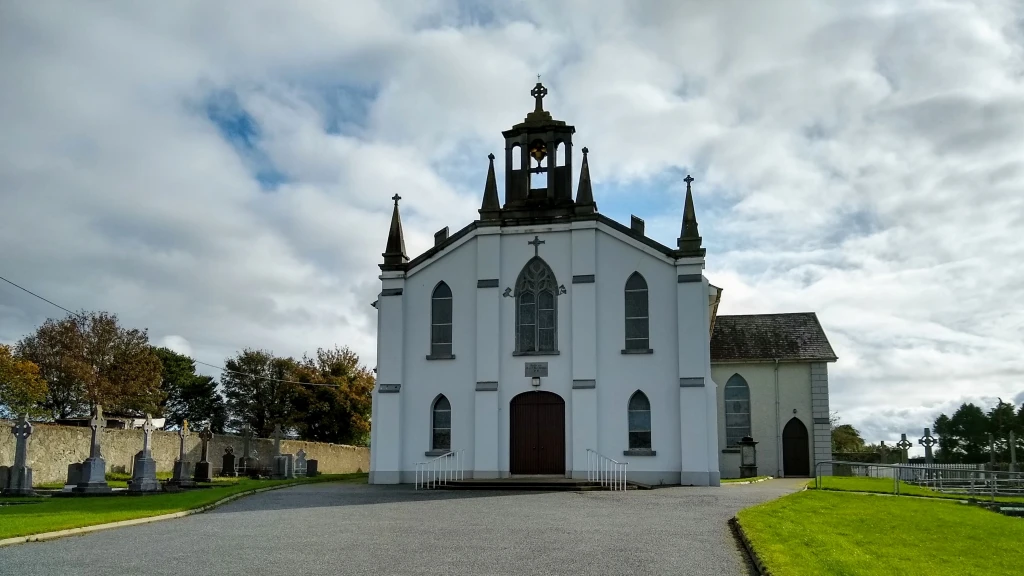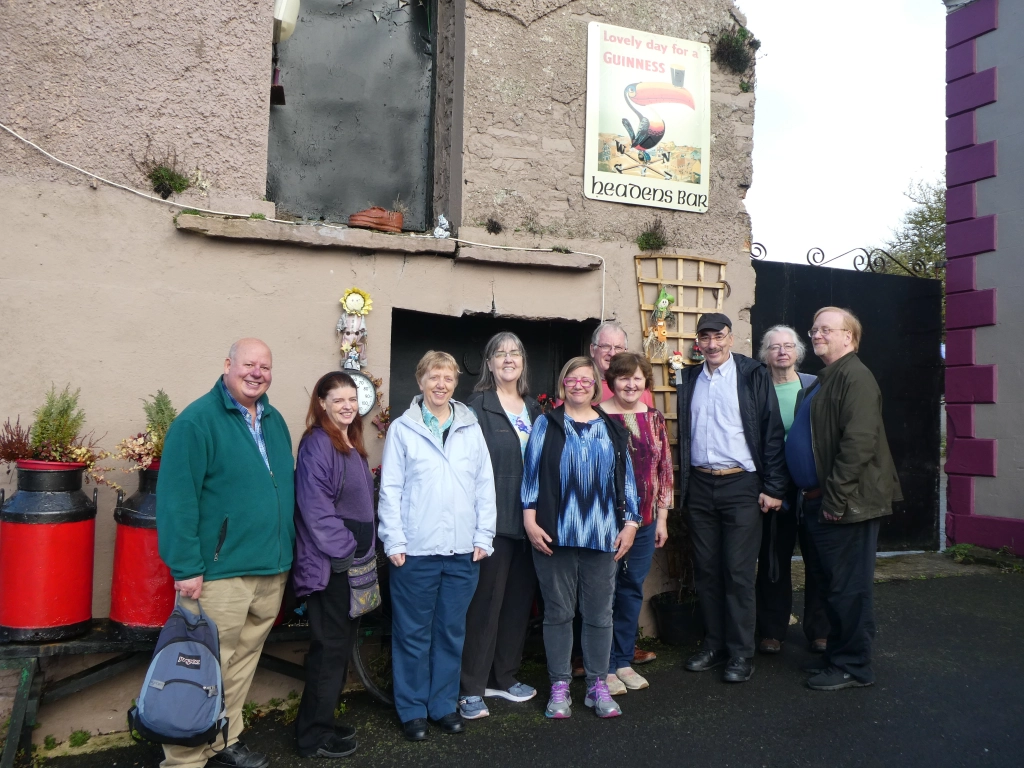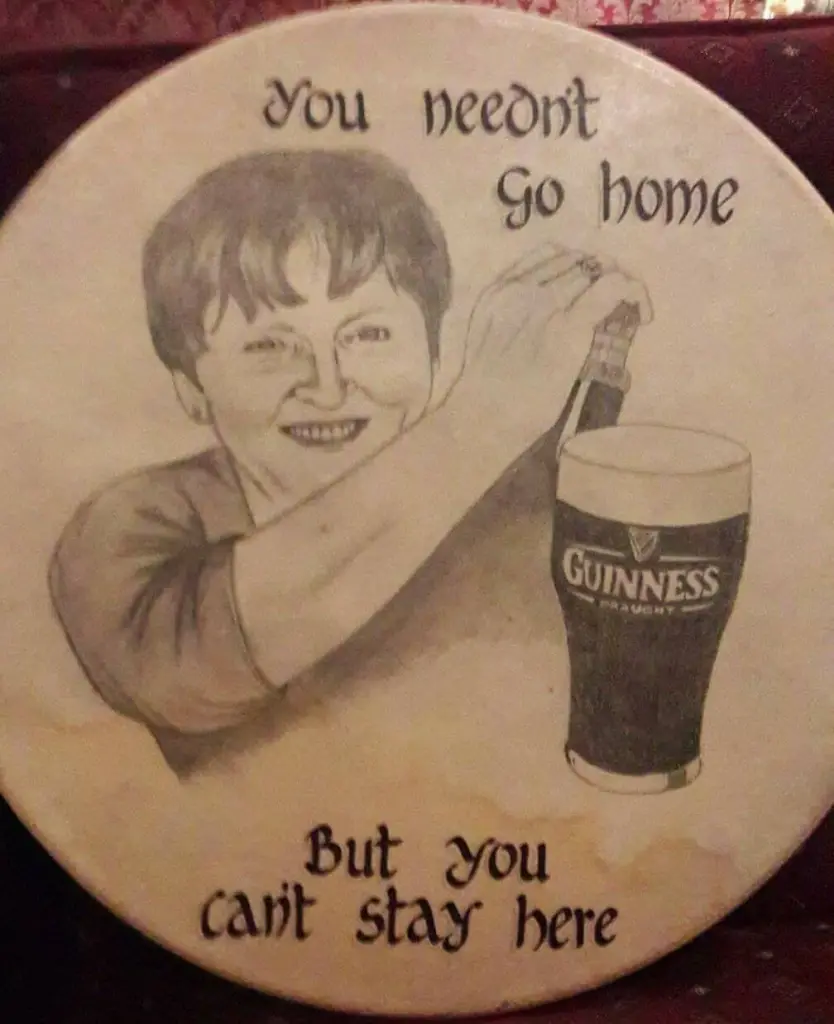Many of us use DNA to search for leads to solving our brick walls. Sometimes, there are no surviving records on the other side of that brick wall, and a common ancestor with a match may never be identified. DNA testing can still be rewarding! Case in point – October is the one-year anniversary of one of my favorite DNA results, a match I wasn’t even looking for.
My great-great-great grandfather, Michael Darcy, was born in Ireland about 1797. He married a lass named Mary Tynan. They were poor, Catholic tenant farmers and I doubt I’ll ever find their parents. I don’t mind. I’m thrilled just to know where they came from.
Almost 200 years ago, the Irish government identified heads-of-households occupying one or more acres, to determine how much to collect in tithes to the Church of Ireland. In 1825, they surveyed Co. Kilkenny and located Michael Darcy in the townland of Donoughmore, a village of just 44 households in northern County Kilkenny, near the border with County Laois. See image 1. Being Catholic, Michael refused to contribute and he was included in the list of Tithe Defaulters, during the ‘Tithe War’ ca. 1831.
Between 1824 and 1840, Michael and Mary had seven children, all baptized in the Roman Catholic parish of Johnstown. I descend from the youngest child, John.
Today, about 20 miles away from Johnstown, Cousin Julia and her husband John own a traditional country pub. Julia is one of my DNA matches, but finding her was a bit serendipitous. We only share 12 cM. Julia would never have come to my attention, except that she matches my sister Sheila for 56.5 cM. Not counting close family that I recruited, she was in Sheila’s top 10 matches.
- Lesson 1: it can be worthwhile to test siblings! They may match distant cousins that we don’t—or share more DNA with someone than we do.
- Lesson 2: consider ‘fishing in multiple ponds.’ Julia didn’t test at Ancestry, and if my family had only tested there, we might not have connected. But her results are at FamilyTreeDNA, MyHeritage, and GEDmatch. Ours are too, in addition to Ancestry, and some at 23andMe and LivingDNA.
While my ggg-grandparents Michael Darcy and Mary Tynan were raising their family in Donoughmore and attending church in nearby Johnstown, Cousin Julia’s ggg-grandparents John Tynan and Mary Butler were living in Donoughmore too. Their son, Julia’s gg-grandfather, was baptized in the same Catholic parish in 1835 as my kin.
Image 2 shows the Catholic Church there, which was built in 1831.

Were my ggg-grandmother Mary Tynan and Julia’s ggg-grandfather John Tynan sister and brother? We’ll likely never know. Perhaps they were cousins. Possibly, we aren’t related via our common surname Tynan. Just because we have matching DNA segments and a common surname in the same time and place doesn’t prove we’re related on that line. All of Julia’s known ancestors came from that area; we could be related farther back, on a different line of hers.
If Mary Tynan and John Tynan were siblings, Julia would be a fifth cousin to my sister and me. I can’t prove that degree of relationship, but can I disprove it, based on how much DNA we share? According to the Shared cM Project, fifth cousins may share 0-117 cM (mostly in the 0-80 cM range), with an average match size of 25 cM. My sister matched Julia for 56 cM; I matched her for 12 cM. Fifth cousin is a reasonable prediction. But so is sixth cousin, sharing an average of 18 cM, with a range of 0-71 cM.
Note: if Sheila matched Julia on multiple very small segments that totaled 56 cM, that would not be as reliable a figure. On MyHeritage, they match on four segments: one > 20 cM, one > 16, and two > 9. I did a study where I found one in four of my son’s matches from 7 to 10 cM were apparently false positives, but having the larger segments here with Julia is reassuring.
Can I be confident that our common ancestor is on my Darcy-Tynan line, and not some other branch on my tree?
My sister and I descend from Michael Darcy and Mary Tynan’s son John. We also have a fourth cousin MC who descends from John’s sister Betsy, and another fourth cousin MG who descends from John’s sister Bridget. Their DNA results, like Julia’s and my sister’s and mine, are on GEDmatch.
Julia matches MC for 10+ cM, on a chromosome 9 segment that triangulates with Sheila. Julia matches MG for 16+ cM on a chromosome 8 segment that also triangulates with Sheila.
Now, triangulation is a nice-to-have. It means three or more people have identical or overlapping DNA segments, on the same place on the same chromosome, so that one segment came to all of them from the same common ancestor. Sometimes this shared piece of DNA might be in what’s sometimes called a ‘pile-up’ region, with lots of matches more likely due to shared ethnic history than recent common ancestry. See https://isogg.org/wiki/Identical_by_descent for more on this. So, I checked these segments using the Tier 1 ‘segment search’ on GEDmatch, and confirmed that this network of testers had very few other matches at those chromosome locations. I believe those DNA segments are more likely from a recent common ancestor.
These matches are not enough DNA evidence to prove that my Mary Tynan and Julia’s John Tynan were siblings with the same parents. The conclusion I am drawing is that it’s possible Mary and John Tynan were siblings or even cousins, but it’s also possible they weren’t related. But I am confident that one of Mary Tynan’s or Michael Darcy’s ancestors was also an ancestor of Julia’s.
During the Great Hunger, ca. 1847, my Darcy-Tynan ancestors left Co. Kilkenny and came to Ontario, Canada. Julia’s family stayed in Ireland, in that corner where County Kilkenny and County Laois meet, where their family still lives today.
What makes this DNA result so treasured?
Last October my four siblings and available spouses and I took a vacation to Ireland together – something I’ve dreamed of doing for many years. And our very first stop together was Headen’s Bar, owned by Julia and John Headen for the last 30+ years.

They were so welcoming! They invited us into their home, offered us tea and cookies, and told us John and Julia had both taken DNA tests because with their roots in the same area for so many generations, they wanted to make sure they weren’t related!
We discovered that my sister Sheila’s name in Irish is spelled Síle (pronounced the same), and it’s a name found in Julia’s family too!
After chatting in their kitchen and sitting room, they invited us to explore the attached family-owned bar. A life-size mural covers an entire wall, depicting a group of regular patrons—four older gents in caps —enjoying the ambiance of Headen’s Pub. There’s also a funny sketch of a smiling Julia pouring a pint, adorned with the closing-time admonition You needn’t go home, but you can’t stay here.

We got to learn a bit about what their daily lives were like. For example, running a local bar in rural Ireland involves responsibilities I’d never considered. There is no public transportation or cab service out there, so if customers can’t make their way home safely, the owners drive them. One time, they filled the car with folks to take home, and by the time they got back to the pub, the first man they had dropped off had already returned!
Getting to meet an Irish family, in the area where our ancestors walked the same Mass paths almost 200 years ago, was a highlight of our trip. We’ve kept in touch with Julia and John, and my heart has gone out to them with the Covid-19 closure of bars this year. I’m happy to report after six months, they are open again! The mural has even been updated accordingly – see image 5!

DNA testing, like genealogy in general, isn’t only about solving puzzles (fun as that can be!) Connecting with new cousins can be a treasured experience too.
© Oct 2020, Ann Raymont, CG®


SO glad you made that connection! How awesome.
LikeLiked by 1 person
What a great story. I loved your use of DNA.
LikeLiked by 1 person
Love the story and agree that it’s much more than proving MRCA but getting a feel for our roots.
I too have met with cousins in England who share a common ancestors and it was wonderful. Local knowledge and stories were a rich addition to my story.
Cheers
LikeLiked by 1 person
Pingback: Friday's Family History Finds | Empty Branches on the Family Tree
Great story of discovery! My husband’s Mulhall line goes back to Rathdowney in Laois. Did you connect with a genealogical society to help you in Ireland?
LikeLike
Isn’t it exciting to find that point of origin in Ireland?! I have not connected with genealogical societies within Ireland, but I do belong to some specific-area Facebook genealogy groups for other lines where I still hope to make discoveries.
LikeLike
I too have a Michael Darcy (Darcey) ancestor, though from Tipperary
Love Serendipity. I too remember anniversaries of significant DNA matches and genealogy finds
LikeLiked by 1 person
Loved your post, very exciting discovery.
LikeLiked by 1 person